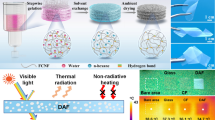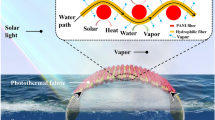Abstract
Inspired by natural creatures that live in the arid climate, fog harvesting can be an efficient approach to overcome freshwater scarcity. Fog harvesting ability of the creatures is mainly based on wettability differences of their surfaces. In this study, inspired by creatures that have hydrophilic regions surrounded by hydrophobic areas, a novel all-dry patterning method was applied to fabricate hydrophilic/hydrophobic patterned surfaces for fog harvesting. For this purpose, patterned surfaces were produced using plasma-enhanced chemical vapor deposition (PECVD) method with the help of a commercial magnet and iron powders. The idea behind the use of the magnetic field during PECVD deposition is to hold light iron particles on the substrate under the vacuum environment for masking substrate surface. For the first time, the magnetic field was used to fabricate patterned surfaces in vapor-phase polymerization. Ordinary glass slides were successfully transformed into hydrophilic/hydrophobic patterned glasses. The obtained results showed that the combination of hydrophobic and hydrophilic regions improved the fog harvesting performance.








Similar content being viewed by others
References
Supply WUJW, Programme SM (2014) Progress on drinking water and sanitation: 2014 update. World Health Organization
Gürsoy M, Karaman M (2017) Surfaces in nature. Surface treatments for biological, chemical, and physical applications. 1–21
Gleick PH (1993) Water in crisis. Pacific Institute for Studies in Dev, Environment & Security Stockholm Env Institute, Oxford Univ Press 473p 9
Wenten I (2016) Reverse osmosis applications: prospect and challenges. Desalination 391:112–125
Khoshrou I, Nasr MJ, Bakhtari K (2017) New opportunities in mass and energy consumption of the multi-stage flash distillation type of brackish water desalination process. Sol Energy 153:115–125
Gürsoy M, Harris M, Downing J, Barrientos-Palomo S, Carletto A, Yaprak A, Karaman M, Badyal J (2017) Bioinspired fog capture and channel mechanism based on the arid climate plant Salsola crassa. Colloids Surf A Physicochem Eng Asp 529:195–202
Shigezawa N, Ito F, Murakami Y, Yamanaka S, Morikawa H (2016) Development of combination textile of thin and thick fiber for fog collection bioinspired by Burkheya purpurea. J Text Instit 107(8):1014–1021
Wen C, Guo H, Bai H, Xu T, Liu M, Yang J, Zhu Y, Zhao W, Zhang J, Cao M (2019) Beetle-inspired hierarchical antibacterial interface for reliable fog harvesting. ACS Appl Mater Interfaces 11(37):34330–34337
Müller FA, Kunz C, Gräf S (2016) Bio-inspired functional surfaces based on laser-induced periodic surface structures. Materials 9(6):476
Moazzam P, Tavassoli H, Razmjou A, Warkiani ME, Asadnia M (2018) Mist harvesting using bioinspired polydopamine coating and microfabrication technology. Desalination 429:111–118
Hu R, Wang N, Hou L, Cui Z, Liu J, Li D, Li Q, Zhang H, Zhao Y (2019) A bioinspired hybrid membrane with wettability and topology anisotropy for highly efficient fog collection. J Mater Chem A 7(1):124–132
Raut HK, Ranganath AS, Baji A, Wood KL (2019) Bio-inspired hierarchical topography for texture driven fog harvesting. Appl Surf Sci 465:362–368
Andrews H, Eccles E, Schofield W, Badyal J (2011) Three-dimensional hierarchical structures for fog harvesting. Langmuir 27(7):3798–3802
Zhai L, Berg MC, Cebeci FC, Kim Y, Milwid JM, Rubner MF, Cohen RE (2006) Patterned superhydrophobic surfaces: toward a synthetic mimic of the Namib Desert beetle. Nano Lett 6(6):1213–1217
Parker AR, Lawrence CR (2001) Water capture by a desert beetle. Nature 414(6859):33–34
Xu C, Feng R, Song F, Wang X-L, Wang Y-Z (2018) Desert beetle-inspired superhydrophilic/superhydrophobic patterned cellulose film with efficient water collection and antibacterial performance. ACS Sustain Chem Eng 6(11):14679–14684
Yang X, Song J, Liu J, Liu X, Jin Z (2017) A twice electrochemical-etching method to fabricate superhydrophobic-superhydrophilic patterns for biomimetic fog harvest. Sci Rep 7(1):8816
White B, Sarkar A, Kietzig A-M (2013) Fog-harvesting inspired by the Stenocara beetle—an analysis of drop collection and removal from biomimetic samples with wetting contrast. Appl Surf Sci 284:826–836
Bai H, Zhang C, Long Z, Geng H, Ba T, Fan Y, Yu C, Li K, Cao M, Jiang L (2018) A hierarchical hydrophilic/hydrophobic cooperative fog collector possessing self-pumped droplet delivering ability. J Mater Chem A 6(42):20966–20972
Wang M, Liu Q, Zhang H, Wang C, Wang L, Xiang B, Fan Y, Guo CF, Ruan S (2017) Laser direct writing of tree-shaped hierarchical cones on a superhydrophobic film for high-efficiency water collection. ACS Appl Mater Interfaces 9(34):29248–29254
Mammen L, Bley K, Papadopoulos P, Schellenberger F, Encinas N, Butt H-J, Weiss CK, Vollmer D (2015) Functional superhydrophobic surfaces made of Janus micropillars. Soft Matter 11(3):506–515
Lee A, Moon M-W, Lim H, Kim W-D, Kim H-Y (2012) Water harvest via dewing. Langmuir 28(27):10183–10191
Zhou H, Wang H, Niu H, Lin T (2013) Superphobicity/philicity janus fabrics with switchable, spontaneous, directional transport ability to water and oil fluids. Sci Rep 3:2964
Sharma V, Orejon D, Takata Y, Krishnan V, Harish S (2018) Gladiolus dalenii based bioinspired structured surface via soft lithography and its application in water vapor condensation and fog harvesting. ACS Sustain Chem Eng 6(5):6981–6993
Yin K, Yang S, Dong X, Chu D, Duan J-A, He J (2018) Ultrafast achievement of a superhydrophilic/hydrophobic janus foam by femtosecond laser ablation for directional water transport and efficient fog harvesting. ACS Appl Mater Interfaces 10(37):31433–31440
Gürsoy M, Harris M, Carletto A, Yaprak A, Karaman M, Badyal J (2017) Bioinspired asymmetric-anisotropic (directional) fog harvesting based on the arid climate plant Eremopyrum orientale. Colloids Surf A Physicochem Eng Asp 529:959–965
Gürsoy M, Uçar T, Tosun Z, Karaman M (2016) Initiation of 2-hydroxyethyl methacrylate polymerization by tert-butyl peroxide in a planar PECVD system. Plasma Process Polym 13(4):438–446
Gürsoy M, Karaman M (2016) Hydrophobic coating of expanded perlite particles by plasma polymerization. Chem Eng J 284:343–350
Lin-Vien D, Colthup NB, Fateley WG, Grasselli JG (1991) The handbook of infrared and Raman characteristic frequencies of organic molecules. Elsevier
Gürsoy M, Karaman M (2015) Effect of substrate temperature on initiated plasma enhanced chemical vapor deposition of PHEMA thin films. Phys Status Solidi C 12(7):1006–1010
Gürsoy M, Karaman M (2018) Improvement of wetting properties of expanded perlite particles by an organic conformal coating. Prog Org Coat 120:190–197
Song Y-y, Liu Y, Jiang H-b, Li S-y, Kaya C, Stegmaier T, Han Z-w, Ren L-q (2018) A bioinspired structured graphene surface with tunable wetting and high wearable properties for efficient fog collection. Nanoscale 10(34):16127–16137
Ozden S, Ge L, Narayanan TN, Hart AH, Yang H, Sridhar S, Vajtai R, Ajayan PM (2014) Anisotropically functionalized carbon nanotube array based hygroscopic scaffolds. ACS Appl Mater Interfaces 6(13):10608–10613
Cao M, Xiao J, Yu C, Li K, Jiang L (2015) Hydrophobic/hydrophilic cooperative Janus system for enhancement of fog collection. Small 11(34):4379–4384
Garrod R, Harris L, Schofield W, McGettrick J, Ward L, Teare D, Badyal J (2007) Mimicking a Stenocara Beetle’s back for microcondensation using plasmachemical patterned superhydrophobic− superhydrophilic surfaces. Langmuir 23(2):689–693
Kostal E, Stroj S, Kasemann S, Matylitsky V, Domke M (2018) Fabrication of biomimetic fog-collecting superhydrophilic–superhydrophobic surface micropatterns using femtosecond lasers. Langmuir 34(9):2933–2941
Bai H, Wang L, Ju J, Sun R, Zheng Y, Jiang L (2014) Efficient water collection on integrative bioinspired surfaces with star-shaped wettability patterns. Adv Mater 26(29):5025–5030
Kim NK, Kang DH, Eom H, Kang HW (2019) Biomimetic fog harvesting surface by photo-induced micro-patterning of zinc-oxide silver hierarchical nanostructures. Appl Surf Sci 470:161–167
Von Spreckelsen RM, Harris MT, Wigzell JM, Fraser RC, Carletto A, Mosquin DP, Justice D, Badyal JPS (2015) Bioinspired breathable architecture for water harvesting. Sci Rep 5:16798
Reed R, Godfrey S, Kayaga S, Reed B, Rouse J, Fisher J, Vilholth K, Odhiambo F (2013) Technical notes on drinking-water, sanitation and hygiene in emergencies. WEDC, Loughborough University© World Health Organisation
Schemenauer RS, Joe PI (1989) The collection efficiency of a massive fog collector. Atmos Res 24(1–4):53–69
Funding
This study was supported by the Scientific and Technological Research Council of Turkey (TÜBİTAK) with a grant number of 119M227.
Author information
Authors and Affiliations
Corresponding author
Ethics declarations
Conflict of interest
The author declares that he has no conflict of interest.
Additional information
Publisher’s note
Springer Nature remains neutral with regard to jurisdictional claims in published maps and institutional affiliations.
Rights and permissions
About this article
Cite this article
Gürsoy, M. All-dry patterning method to fabricate hydrophilic/hydrophobic surface for fog harvesting. Colloid Polym Sci 298, 969–976 (2020). https://doi.org/10.1007/s00396-020-04656-x
Received:
Revised:
Accepted:
Published:
Issue Date:
DOI: https://doi.org/10.1007/s00396-020-04656-x




